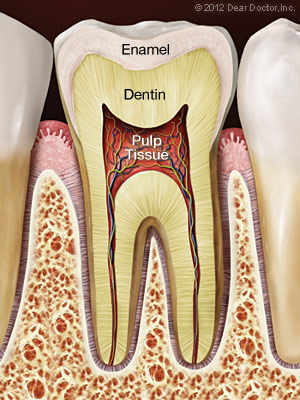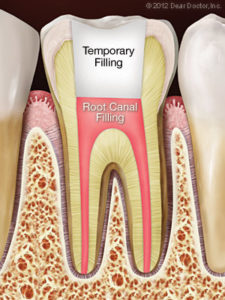Root Canals (endodontics)
We offer our patients the latest in root canal therapy. When the damage goes beyond what can be treated with a filling, we can perform a root canal to preserve the tooth and retain its original integrity. A root canal is a procedure that extracts decayed pulp from the central part of the tooth, reshapes the canal and replaces it with strengthened filler.
The common misconception is that a root canal is a painful procedure. Actually, root canals are similar to having a cavity filled.
Problems That May Require a Root Canal
- Inflamed/infected tooth pulp
- Swelling or tenderness near the infected tooth
- Severe sensitivity to hot and cold elements
- Tooth decay
- Chipped or broken tooth
- Blow to the tooth
- Repeat dental procedures on a single tooth
When left untreated, these problems can lead to severe tooth decay reaching the root of the tooth, causing extensive damage to the tooth structure.
Steps of a Root Canal
- You undergo anesthesia.
- A dental dam is used to isolate the tooth.
- The tooth is opened to allow for removal of infected or dead dental pulp.
- The tooth is comprehensively cleaned.
- With special tools, the canal is reshaped.
- The tooth is filled with biocompatible filling material.
- A temporary covering is used over the access opening.
- Following a recovery period, you will return for the placement of a permanent restoration.
Endodontics is the dental specialty that deals with tissues and structures located inside the tooth. One of the most common endodontic treatments is root canal therapy, a procedure which effectively eases the pain associated with a bacterial infection deep within the pulp of the tooth. Of course, root canal treatment doesn’t just relieve pain — it also stops the infection by removing dead and dying tissue from the tooth’s pulp. Plus, it helps to save the tooth, which is in danger of being lost if left untreated.
Yet root canal therapy isn’t the only treatment endodontics offers. This field also deals with cases of dental trauma, performs microsurgery on the tips of the tooth’s roots, and even helps figure out what’s going on when tooth pain seems to come and go intermittently, or when the pain isn’t localized at one tooth. So when it comes to preserving your natural teeth, endodontics has plenty of ways to help.
The Inside Story
 What’s inside your teeth? Behind the tough, shiny enamel of the tooth’s visible crown lies the sturdy inner tissue called dentin. Dentin is also found behind the cementum that forms the outer layer of the tooth’s roots — in fact, it makes up the bulk of the tooth’s structure. Similar in many ways to bone tissue, dentin is composed of many tiny tubules which can transmit sensations to nerve cells when it is stimulated.
What’s inside your teeth? Behind the tough, shiny enamel of the tooth’s visible crown lies the sturdy inner tissue called dentin. Dentin is also found behind the cementum that forms the outer layer of the tooth’s roots — in fact, it makes up the bulk of the tooth’s structure. Similar in many ways to bone tissue, dentin is composed of many tiny tubules which can transmit sensations to nerve cells when it is stimulated.
At the core of the tooth, inside small, branching chambers called the root canals, we find the soft pulp tissue. This consists of nerves, connective tissues and blood vessels which extend into the center of the tooth and exit through canals near the apex (tip) of the tooth’s roots. When problems (such as infection and inflammation) develop in the pulp tissue, your first indication of trouble may be tooth sensitivity — or intense pain. In time, as the nerves die, the pain may go away… but the problem won’t. In fact, if left untreated, the end result may be tooth loss.
The “Root” of the Problem

What could cause the pulp tissue to become diseased and lead to root canal problems? One potential source of infection is untreated tooth decay, which can allow bacteria from the tooth’s surface to work its way deep inside. A crack or fracture in a tooth could offer another pathway for microorganisms to infect the pulp.
Dental trauma — from a sports injury, for example — may also damage dentin or pulp, or expose it to infection. Extensive dental procedures (such as multiple fillings or restorations on the same tooth) may cause trouble; occasionally, even routine procedures like orthodontics may eventually lead to root canal problems.
Endodontic Treatment
The old gag line “I’d rather have a root canal” may still get a laugh — but root canal problems are no joke. It’s important to remember that root canal treatment doesn’t cause pain; it relieves pain. A typical root canal procedure is performed with local anesthetics, and doesn’t cause any more discomfort than having a filling. Here’s what to expect:
First, you will receive anesthesia (usually a numbing shot) — and for many patients, the worst is now over. Next, a small opening is made in the tooth surface to give access to the pulp chamber and root canals. Then, tiny instruments are used — often with the aid of a microscope — to remove dead and dying tissue from inside the narrow passages. These passages are then cleaned, disinfected, and filled with a safe, inert material. Finally, the opening in the tooth is sealed to prevent contamination.
Other endodontic treatments may be recommended for removing sources of infection and preventing future problems. Following an endodontic procedure, a restoration (such as a crown) will be placed on the tooth to restore it to full function and aesthetic appearance. After that, with proper care the restored tooth should last for many years.
If you have been told you need root canal treatment, you may be feeling a bit nervous. Not to worry — treating root canal problems is a routine part of dentistry that can relieve certain kinds of tooth pain and help your teeth last longer. As you learn more about this beneficial procedure, you will understand why it’s needed — and how it will leave you in far better shape than you were when you came in to the dental office! Here are some answers to frequently asked questions.

What is a root canal?
Dentists use the term “root canal” in referring to the tiny, narrow passageways that branch from a central, hollow space in your tooth (called the pulp chamber) down to the ends of the tooth roots. The term can also be used as a shorthand for “root canal treatment” — that is, the procedure used to save the tooth if the soft tissue deep inside of it (called pulp) becomes acutely inflamed or infected.Why do I need root canal treatment?
If tooth pulp becomes acutely inflamed or infected because of decay or injury, we need to remove that tissue in order to save the tooth and stop the infection from spreading. As an adult, you don’t actually need the pulp — its primary use is to aid in tooth development during childhood.Is there an alternative?
We could remove the whole tooth, but it’s always better to try to save it — especially since root canal treatment is routine and has a very high success rate (over 90%). Saving the tooth can prevent other troubles from occurring later on; these could include bite problems from teeth shifting position, difficulty eating, and loss of jawbone volume and density.
Is root canal treatment painful?
The procedure normally causes no more discomfort that a filling would. Root canal treatment may have a bad reputation, but it is undeserved; in this case it’s the disease that’s to blame and not the cure. In other words, the infections that make the treatment necessary in the first place are often painful because they are inflaming tissue that has lots of nerves and therefore is very sensitive. Root canal treatment actually relieves this pain!
What will happen during the procedure?
After numbing the area, we will make a tiny hole in the crown (top) of your tooth to access the pulp chamber and canals. After we remove the diseased tissue, we will disinfect the chamber and the canal(s) all the way to the root end(s). Teeth in the front of the mouth have one root and generally one canal; back teeth have two or three roots and generally three or four canals. We will fill those canals and the pulp chamber with an inert, biocompatible material, and seal it with adhesive cement. The access hole will receive a temporary filling.
What will happen afterwards?
Your tooth may feel sensitive for a few days, but any discomfort can usually be relieved with over-the-counter pain medication or anti-inflammatories like ibuprofen. You will be instructed to avoid chewing on that tooth until it receives its permanent filling, which can be placed a few days later. Depending on how damaged the tooth was to begin with, it may need a full-coverage crown. We will discuss your options with you.
How can I avoid the need for root canal treatment in the future?
Keep your teeth decay-free by brushing and flossing every day. Eat a healthy diet low in sugar and avoid acidic beverages such as soda. Come in to the dental office regularly for professional cleanings and exams. And if you’re active in sports, consider ordering a custom-made mouthguard to protect your teeth from injury.
